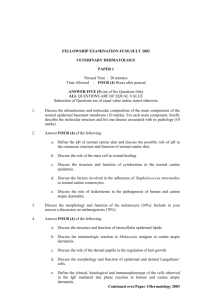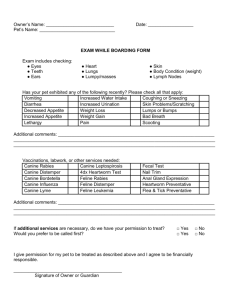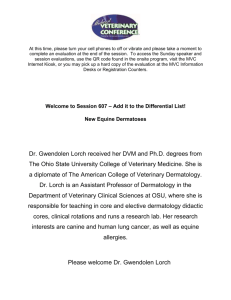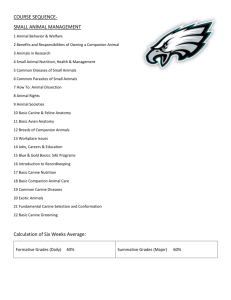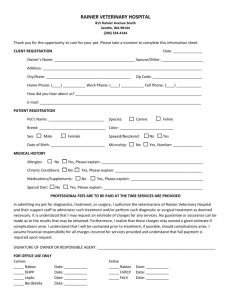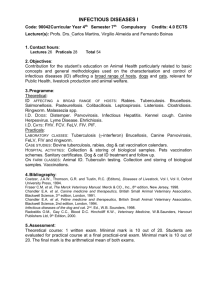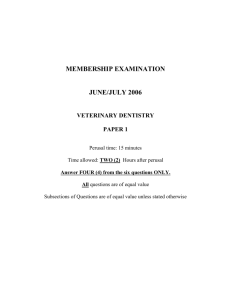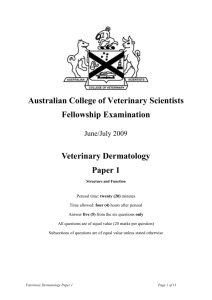Veterinary Dermatology
advertisement
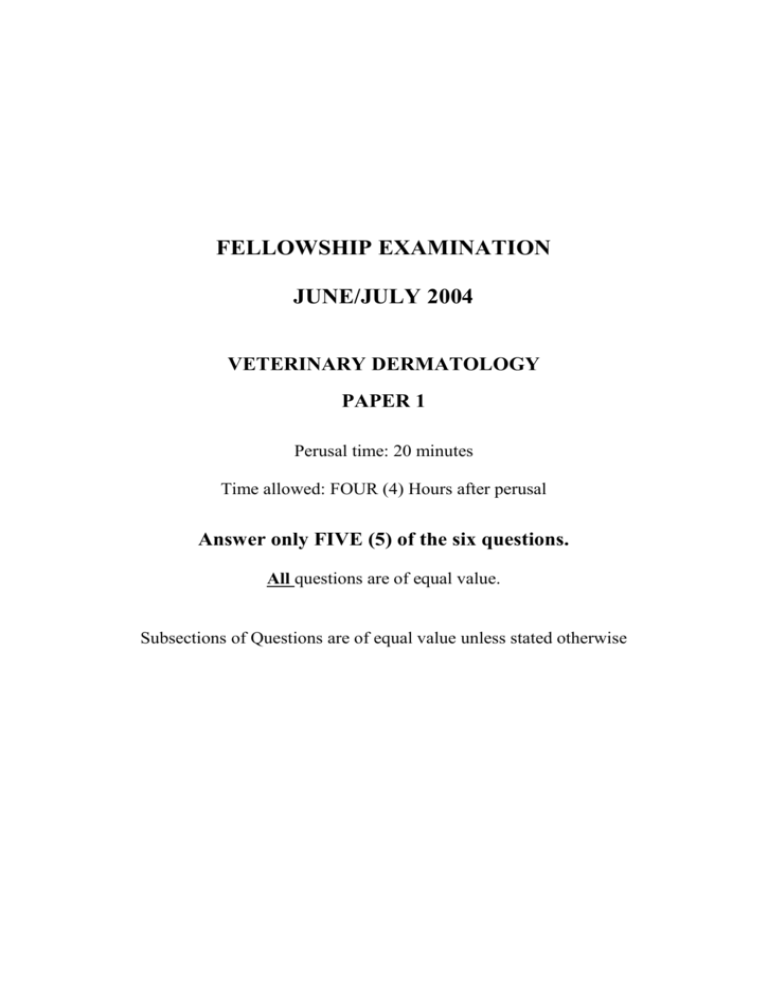
FELLOWSHIP EXAMINATION JUNE/JULY 2004 VETERINARY DERMATOLOGY PAPER 1 Perusal time: 20 minutes Time allowed: FOUR (4) Hours after perusal Answer only FIVE (5) of the six questions. All questions are of equal value. Subsections of Questions are of equal value unless stated otherwise VETERINARY DERMATOLOGY 2004 – FELLOWSHIP – PAPER 1 Answer only FIVE (5) of the six questions. 1. Discuss the structure and function of the mast cell. 2. Answer FOUR (4) of the following: a. Describe the ultrastructure, molecular composition and function of desmosomes in the normal canine epidermis. b. Discuss the mechanisms by which bacterial Pseudomonas infections develop resistance to fluoroquinolone antibiotics. c. Describe the histopathological features and ultrastructure of “flame figures” in the feline eosinophilic granuloma complex. d. Discuss the scientific evidence for a relationship between staphylococcal infections and canine atopic dermatitis. e. Discuss the immunologic features of the immediate and delayed hypersensitivity response in feline dermatophytosis due to Microsporum canis. 3. Discuss the morphology and function of the melanocyte. Include in your answer a discussion of melanogenesis 4. Answer FOUR (4) of the following a. Discuss the role of IgE and IgG in canine food hypersensitivity. b. Describe the structure and function of lamellar bodies (granules) c. Discuss the biology and role of the eosinophil in cutaneous allergic reactions in the dog d. Discuss c-kit mutations in canine mast cell tumours. e. Describe the structure and function of cytokeratins in the normal canine epidermis. 5. Discuss the molecular composition and function of the basement membrane antigens targeted by autoantibodies in canine and feline mucous membrane pemphigoid 6. Discuss hair follicle morphogenesis and the factors that regulate follicle cycling END OF PAPER FELLOWSHIP EXAMINATION JUNE/JULY 2004 VETERINARY DERMATOLOGY PAPER 2 Perusal time: 20 minutes Time allowed: FOUR (4) Hours after perusal Answer only FIVE (5) of the six questions only. All questions are of equal value. Subsections of Questions are of equal value unless stated otherwise VETERINARY DERMATOLOGY 2004 – FELLOWSHIP – PAPER 2 Answer only FIVE (5) of the six questions only. 1. Discuss cutaneous paraneoplastic skin conditions of the dog and cat. Include in your answer a definition and proposed aetiopathogenesis of paraneoplastic skin conditions (20%) and the clinical signs, diagnosis and treatment of the specific syndromes (excluding hyperadrenocorticism) reported in the dog and cat (80%) 2. Write short notes of FOUR (4) of the following: Your answer should include the pathogenesis, and where appropriate, the aetiological agent(s) and mode of transmission (20%), clinical signs (20%), differential diagnoses (20%), diagnostic methods for confirmation of disease (20%) and all treatment options and prognosis (20%). a. b. c. d. e. Vesicular cutaneous lupus erythematosus in Shetland sheepdogs and Collie dogs Hyperoestrogenism in ferrets. Feline orthopoxvirus infection in cats and humans. Hereditary nasal parakeratosis in the dog. Lice infestation in horses, sheep and cats. 3. Discuss the pathogenesis (20%), clinical signs (20%), differential diagnoses (20%), diagnosis (20%) and management options (20%) for equine cutaneous pythiosis. 4. Write short notes on FOUR (4) of the following. Your answer should include: the pathogenesis (20%), clinical signs (20%), differential diagnoses (20%), diagnostic methods for confirmation of disease (20%) and treatment options and prognosis (20%). a. b. c. d. e. 5. Canine lupoid onychodystrophy. Equine purpura haemorrhagica. Psoroptes cuniculi infestation in rabbits. Hypersensitivity dermatitis in psittacines. Malassezia infections in domestic ruminants. A ten year old cat presents with symmetrical alopecia involving the ventrum. List the differential diagnoses (25%) and outline a detailed diagnostic plan to investigate this case (75%). Continued over/Paper 2/Dermatology 2004 Continued /Paper 2/Dermatology 2004 6. Write short notes on FOUR (4) of the following compounds. For each agent, your answer should include the mechanism of action (25%), pharmacodynamics (25%), toxicity (25%) and indications for use (25%). a. b. c. d. e. Lomustine Nitenpyram Ketoconazole Clindamycin Trilostane END OF PAPER
